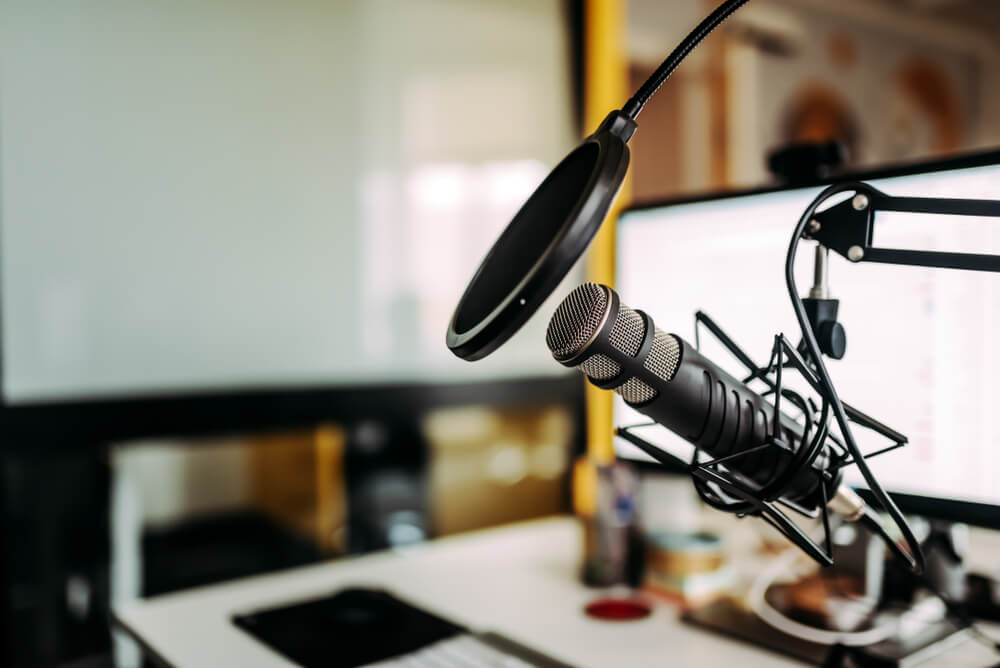1. Microphone:
- A high-quality microphone is essential for clear and professional audio. While there are various types of microphones, a dynamic or condenser microphone is commonly used for podcasting. Popular choices include the Shure SM7B, Audio-Technica AT2020, and the Blue Yeti. A pop filter or windscreen can help reduce plosive sounds (pops) when speaking.
2. Headphones:
- Good headphones are crucial for monitoring audio quality and detecting any issues during recording. Closed-back headphones are preferred to minimize sound leakage. Some podcasters use studio headphones like the Sony MDR-7506 or Audio-Technica ATH-M50x.
3. Audio Interface:
- An audio interface connects your microphone to your computer and converts analog audio signals into digital data. Popular audio interfaces include the Focusrite Scarlett 2i2, PreSonus AudioBox, and Universal Audio Apollo Twin.
4. Boom Arm or Microphone Stand:
- A boom arm or microphone stand holds your microphone in place and allows you to position it at the ideal height and angle for comfortable recording.
5. Acoustic Treatment:
- To improve audio quality, consider adding some acoustic treatment to your recording environment. This may include foam panels, bass traps, and diffusers to reduce echoes and background noise.
6. Recording Software (DAW - Digital Audio Workstation):
- You'll need recording software to capture and edit your podcast. Popular options include Audacity (free), Adobe Audition, GarageBand (for Mac users), and Reaper. These programs allow you to record, edit, and mix your podcast.
7. Pop Filter:
- A pop filter is a screen placed in front of the microphone to reduce popping and plosive sounds when speaking. It helps ensure a clean recording.
8. Shock Mount:
- A shock mount holds the microphone in place and isolates it from vibrations and handling noise, resulting in cleaner audio.
9. XLR Cables:
- High-quality XLR cables are used to connect your microphone to the audio interface. Ensure you have the appropriate cable length for your setup.
10. Hosting and Publishing Platform: - You'll need a podcast hosting platform to store and distribute your podcast episodes. Popular podcast hosting services include Libsyn, Podbean, and Anchor. These services generate an RSS feed that allows your podcast to be distributed to platforms like Apple Podcasts and Spotify.
11. Editing Software: - In addition to your DAW for recording, you may need separate editing software to fine-tune your podcast. Adobe Audition, Audacity, and GarageBand are commonly used for editing.
12. Quiet Recording Environment: - Find a quiet space for recording, preferably a room with minimal background noise and soundproofing. Consider using blankets, foam panels, or curtains to improve sound quality and reduce echo.
13. Skype or Remote Recording Tools: - If you're hosting remote interviews or co-hosting with someone in a different location, tools like Skype, Zoom, or dedicated remote recording services can help you capture high-quality remote audio.
14. Music and Sound Effects: - If you want to add music or sound effects to your podcast, you'll need access to royalty-free music and audio libraries. Be sure to respect copyright laws when using audio content.
15. Script or Outline: - A well-prepared script or outline can help you stay on track and maintain a cohesive narrative during your podcast.
16. Patience and Practice: - Podcasting requires practice, so be patient with yourself. Experiment with different equipment and settings to find the right setup for your needs.
When setting up your podcasting equipment, pay attention to proper microphone positioning, levels, and background noise reduction. Regularly test and monitor your audio quality to ensure a professional and engaging podcast. Over time, you'll develop the skills and expertise needed to create high-quality content that resonates with your audience.




Comments (0)